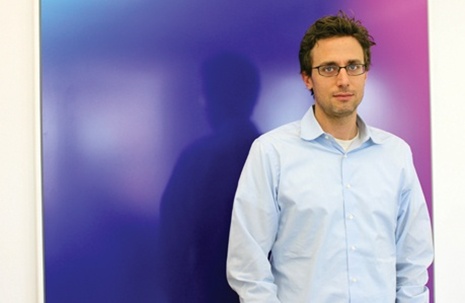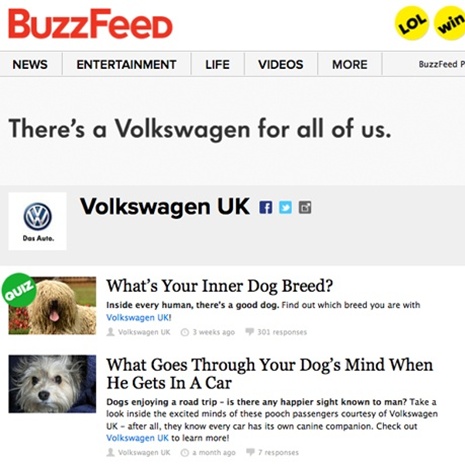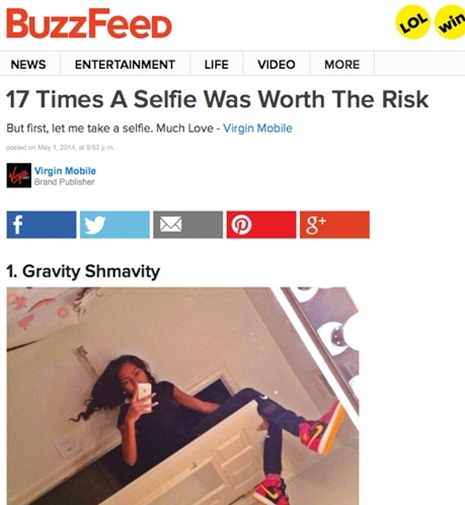Profile interview: Jonah Peretti, founder, BuzzFeed
With 130 million users a month, BuzzFeed is bigger than the BBC outside the UK and wants to ‘do the best social campaigns in the world’. Founder and chief executive Jonah Peretti reveals how brands can create content that engages, spreads and sells.
When it comes to spreading brand messages, Jonah Peretti believes that marketers should act like Mormons. According to the BuzzFeed founder, Mormonism has grown rapidly in recent decades because the religion’s followers devote the same amount of attention to how they spread their message as they do to the message itself. Brands should follow this approach when marketing themselves online, Peretti suggests.
“We can all learn from the Mormons in this industry,” he said at social media conference LiNC 14 in San Francisco last month. “You should spend half your time thinking about your idea and half your time thinking about how to promote it.”
Peretti is an authority on ‘the art and science’ of spreading content, so Mormons should appreciate the namecheck. BuzzFeed was set up eight years ago as a research lab for creating viral content, and has grown into one of the world’s most popular news and entertainment websites with a monthly audience of 130 million unique visitors and an expanding roster of brands signed up to its native advertising offer.
BuzzFeed’s success is rooted in ‘social sharing’, whereby people arrive at the site after clicking on content shared on social media. This currently accounts for 75 per cent of the site’s traffic, which is growing quickly – visitor numbers are up by 53 per cent since last August. In light of this surge, much larger and more established media brands are beginning to pay close attention to the BuzzFeed model.
You should spend half your time thinking about your idea and half your time thinking about how to promote it
Last month, for example, a report on the BBC’s digital operations by former Sony chief executive Sir Howard Stringer noted that BuzzFeed already has a larger global audience than BBC News and BBC Worldwide outside the UK. It commented that while the BBC is the most-tweeted news organisation globally, this does not translate automatically into hits on the website in the same way as BuzzFeed.
“Given that BuzzFeed was only founded in 2006, this raises the question of why the BBC’s global digital reach is not more significant,” said Stringer. “It is impossible to escape the conclusion that the BBC is punching well below its weight in the digital world.”
Speaking to Marketing Week after his keynote address at LiNC, which was hosted by social marketing company Lithium, Peretti argues that traditional media networks are shifting drastically in favour of new online media brands such as BuzzFeed. But he believes that all brands can and must learn to create sharable content.
An alumnus of the MIT Media Lab in the US, Peretti co-founded the Huffington Post with Arianna Huffington before leaving in 2011 to focus on BuzzFeed. He naturally has a forward-looking view on the media landscape and suggests that online media brands can break free from the strictures of more traditional media to reach a potentially limitless audience. He defines this audience, with typical informality, as the ‘bored at work’ network or the ‘bored in line’ network.

BuzzFeed opened a London office last year
The former refers to the “hundreds of millions of bored office workers who spend half their day working and half their day sharing things online”. Peretti argues that brands can reach more people through the ‘bored at work’ network than they can via primetime television.
The ‘bored in line’ network, meanwhile, refers to people who discover content while searching on their phones to pass the time, such as when queuing or relaxing at home. Peretti believes that social media has overtaken search as the primary channel through which people discover content and that mobile is increasingly becoming the device on which they discover it. Around 60 per cent of BuzzFeed’s traffic now comes from mobile phones and around three times as much comes from social networks than from Google.
“The ‘bored in line’ network has become even bigger than the ‘bored at work’ network,” he says. “In the early days of BuzzFeed, our peak traffic was always during the working day but now it’s at about 10pm East Coast time in the US and it’s predominantly mobile traffic.”
But despite BuzzFeed’s eye-catching rise, many commentators continue to look down on the site or dismiss its credentials as a serious media brand. This cynicism is rooted in BuzzFeed’s reputation for churning out lists on disposable subjects such as cute animal pictures or bizarre, true-life tales.
Peretti, however, points to the careful methodology behind all of the site’s sharable content. This approach also informs the more serious journalism that is becoming an increasingly important part of BuzzFeed. Late last year, for example, the company hired Pulitzer Prize winner Mark Schoofs to head a new investigative journalism unit within BuzzFeed and to take advantage of the growing traction obtained by the site’s long-form content.
Emotional connection

Brands are ‘realising that there’s no need to do banner advertising when you can actually tell a story’ claims Peretti
Peretti suggests that content must resonate with people on an emotional level if they are to share it. Even seemingly trivial content has a deeper function that allows people to connect with one another and share their experiences, he claims.
“That’s why there are so many cat pictures on Facebook and Twitter. It’s not because of the content necessarily; it’s because of the communication and connection that it allows,” he says. “Communication and content are starting to merge. It’s not just about getting information in people’s heads; it’s about allowing people to express themselves and connect with others.”
Peretti also argues that people are likely to share content when it allows them to express their identity. BuzzFeed regularly creates posts about specific groups of people to engage them and turn them into advocates for the content. Peretti recalls that a post about the experience of Asian people living in the US attracted an almost equal amount of Asian and non-Asian readers because of the way people shared the content.
“When you make targeted social content, people who are part of a group will share it with each other but they will also share it with their friends who aren’t in that group as a way of communicating their experience,” he says.
The identity-driven nature of social sharing means there are certain forms of content that brands should avoid, however. “I see some marketers make the mistake of saying ‘I’m worried about this campaign. Let’s sex it up or put in girls in bikinis to try to make it perform better.’ It has the opposite effect; no one can share it because it would make them look sleazy.
“Part of the reason you share things is because you’re telling the world who you are, so a better approach for marketers is to think: ‘How can I make this content smarter, more social and more inspiring?’ That’s what people want to share.”
Scientific measurement
While brands need artistic flair and vision to create viral content, the process also requires rigorous scientific measurement and execution. BuzzFeed tracks the data behind all of its posts to determine what people are sharing and why. Peretti explains that this often involves testing different variables against the same post to identify the factors that prompt people to share.
“If we did a post featuring corgis that was really popular, you might think that it is because people love corgis,” he says. “We will therefore decide to do something different that doesn’t involve corgis but that uses all the other elements from the post in a similar way. That helps us to learn what people are more likely to share so that we can make the content better.”
The company also uses data to target related articles at people according to the content they land on.
Social sharing is further encouraged by subtle changes to the site’s presentation depending on the network that people use to access the content. For example, BuzzFeed found that Pinterest users who saw its posts and clicked through were likely to share the content back to Pinterest and Facebook, but unlikely to share on Twitter. The company therefore switched the share buttons on its pages for people arriving from Pinterest so that the Pin It button appears first and the Twitter button last. This change resulted in a 110 per cent uplift in Pinterest users sharing content, according to Peretti.
“By understanding how people are consuming content and by making lots of little shifts like that, we can make a better platform for distributing content that means when things are published on BuzzFeed they will spread at a higher rate than if they were published somewhere else,” he says.
This proposition is helping BuzzFeed to attract a growing list of major advertisers to the site. The company’s revenues are generated entirely from its native advertising model, which involves helping brands to create sponsored posts that visitors to the site will want to share. BuzzFeed has more than 60 of the 100 biggest US brands by revenue on board and is growing its client base in the UK, where it opened an office last year.
Blurred lines

Native advertising has caused controversy in the media industry, particularly where the lines between editorial and branded content have blurred. Last month, BuzzFeed changed the labels on its sponsored pages to ensure that branded content is signposted with greater clarity. The page label has changed from ‘featured partner’ to ‘brand publisher’, for example.
Peretti insists that there is a clear “church-state separation” between advertisers and the editorial operation at BuzzFeed that prevents any conflict of interest between the two sides. He believes that branded content adds value for publishers by removing the need for online banner ads, while advertisers benefit by having the opportunity to tell their stories in greater depth and potentially extend their reach through social sharing.
BuzzFeed advises clients to find the ‘sweet spot’ with content that aligns with their brand message but that people will still want to share. Recent examples on the site include a British Airways post entitled ‘50 Things To Do In Europe In Your Lifetime’ and a Volkswagen article called ‘18 Dogs Who Love The Open Road’ (see Branded Posts, below[1]).
BuzzFeed does not release data on all its advertisers, but it highlights certain case studies, including a campaign for Virgin Mobile that consisted of 190 branded posts and was viewed 9.7 million times. This includes 600,000 views via social media for a post entitled ‘27 Cats That Just Can’t Handle It’.
“We hold brands to a higher standard so that they actually have to make content that is worth clicking on or worth sharing,” says Peretti. “Brands are realising that they need to speak the language of the web and that there’s no need to do banner advertising when you can actually tell a story.”
In a memo to staff last September, Peretti announced that BuzzFeed “has gone from zero revenue four years ago to a profitable company with over 300 employees”. This move into profitability coincides with an acceleration of the company’s growth plans, which include opening further global offices to add to its headquarters in New York and bases in Los Angeles, London, Paris, São Paulo and Sydney.
BuzzFeed also expects to publish the first stories from its investigative journalism bureau in the coming months and is ramping up production at its video content studio, which opened in 2012 and hit 200 million views in one month earlier this year.
Peretti believes that as technology continues to disrupt the way people consume media, online companies such as BuzzFeed are following a similar trajectory to film studios and TV stations, which started small, often with limited content, before expanding to become mainstream content providers.
“We’re starting to see the beginning of a new generation of media companies that take advantage of the huge shift in media consumption to mobile and social and use that to build a new type of company for the way people consume media today, as opposed to how they did 10 years ago.”

Supplements editor Michael Barnett says: too many brands are creating content that nobody wants, so keep it interesting – and don’t sell. Find out how here:
How to create content that truly adds value[2]
Marketers are spotting a correlation between ‘owned media’ and traditional paid-for formats and consumers are viewing content positively. Lou Cooper’s trends piece examines the differences between how marketers and consumers view content marketing.
Don’t be content with the old ways[3]
8 Jonah Peretti’s tips for getting content shared online
1 Tell Stories
“Powerful human stories are often what people share and engage with.”
2 Be Funny
“Humour is inherently social. When you see a group of people laughing together you want to be a part of it, so humour is a great way to connect.”
3 Connect With People’s Identities
“Identity is a very powerful driver of sharing on the social web. When you share something, you’re telling people who you are.”
4 Respond To Events
“If everyone is experiencing something at the same time then they want to be a part of that and share it together.”
5 Think Socially
“Don’t post things people would be embarrassed to share.”
6 Tap Into Shared Emotions
“Sharing cute animal content isn’t just about the cute animals. It’s about feeling an emotion at the same time as someone else.”
7 Measure Results
“There is a science behind the social web. Data allows creative people to track the right ideas more quickly and learn as they go.”
8 Know Your Platform
“There isn’t something that’s inherently viral or not viral. It depends on who the audience is, what network they’re on and the kind of behaviours on the network.”
18 Dogs who love the open road and other BuzzFeed branded posts

Last month, BuzzFeed changed the labels on its sponsored pages to ensure that branded content is signposted with greater clarity
10 Skin Care Tips Every Woman Should Know - Dove
The Only Road Trip Playlist You’ll Ever Need - Toyota Corolla
12 Things British People Are Tired Of Hearing - British Airways
30 Amazing Summer Sunsets To Help You Feel Zen - Canon
25 Songs Surely Written For The Perfect Slow Dance - Spotify
10 Pieces Of Vintage Technology We Couldn’t Wait To Have - Intel
Amazing Illustrations Of Concept Inventions Imagined By You - GE
The 11 Greatest Weathermen Of All Time - Anchorman 2: The Legend Continues
10 Not Normal Phenomena That Actually Exist - Mini
12 Everyday Moments You’d Never Want To Miss - Acuvue
The 11 Best Smells Of Christmas - Glade
13 GIFs That Will Sweeten Your Day - Honey Nut Cheerios
10 Actors Who Created And Starred In Their Own TV Shows - HBO
18 Dogs Who Love The Open Road - Volkswagen
References
- ^ Branded Posts, below (www.marketingweek.co.uk)
- ^ How to create content that truly adds value (www.marketingweek.co.uk)
- ^ Don’t be content with the old ways (www.marketingweek.co.uk)









